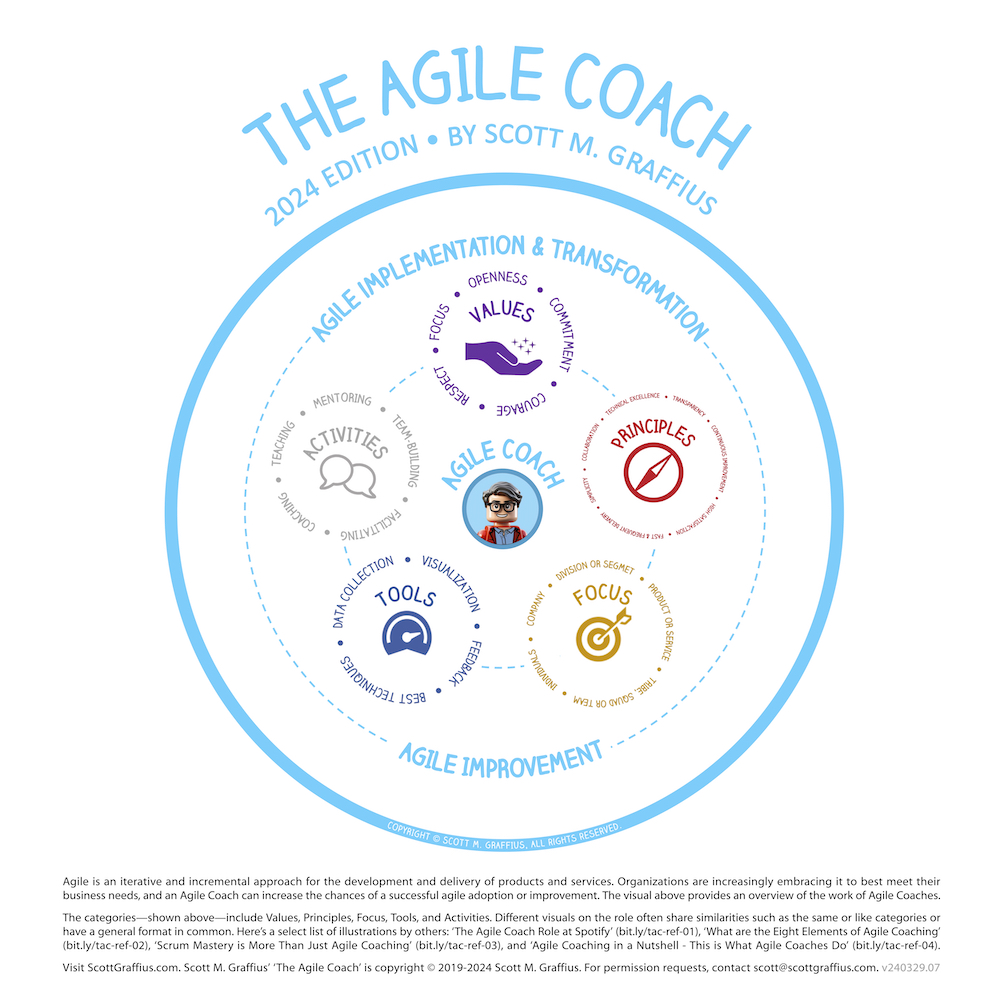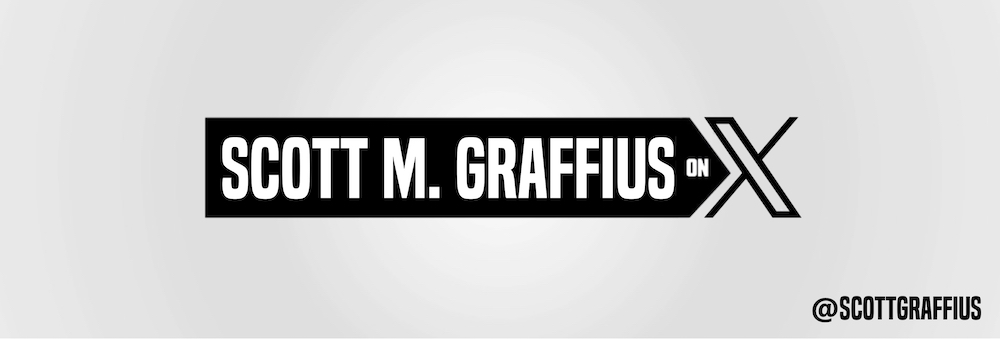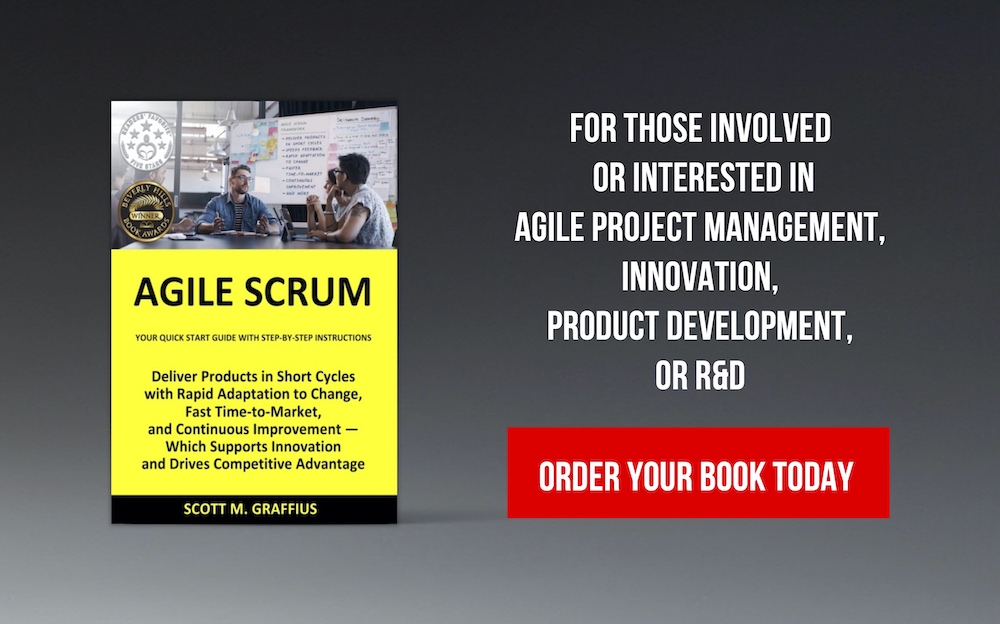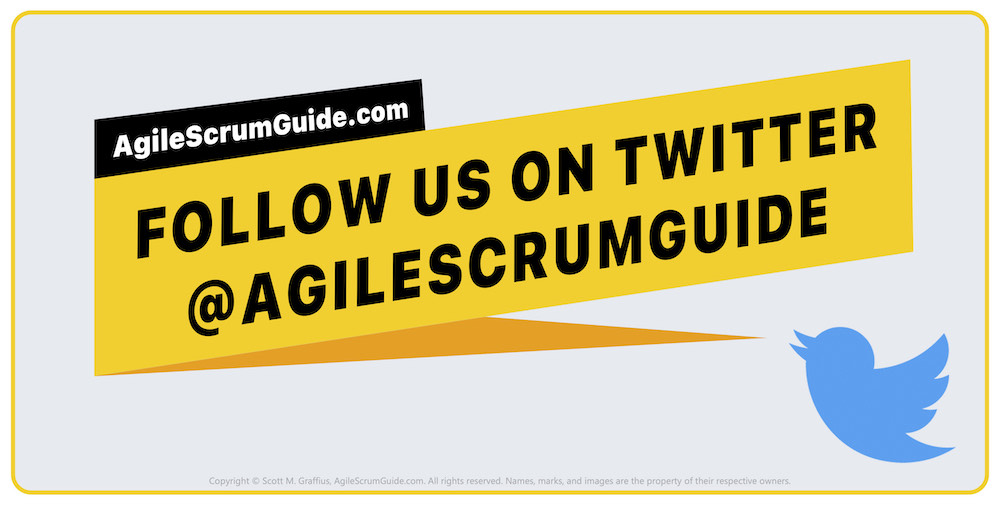The Agile Coach: 2024 Edition




This article presents the 2024 edition of The Agile Coach infographic visual developed by Scott M. Graffius. It also provides details on the work of Agile Coaches. Including supporting information, it's organized into eight sections:
- Introduction
- The Agile Coach Infographic Visual
- Values, Guiding Principles, Focus Areas, Tools, and Activities for Agile Coaches
- The Agile Coach as a Change Agent
- Conclusion
- References
- How to Cite This Article
- How to Request Permission


Introduction
The demand for Agile—and Agile expertise—is soaring. Here are apt quotes on customer needs and the most popular Agile approach, Scrum.
"Shifting customer needs are common in today's marketplace. Businesses must be adaptive and responsive to change while delivering an exceptional customer experience to be competitive. Traditional development and delivery frameworks such as waterfall are often ineffective. In contrast, Scrum is a value-driven agile approach which incorporates adjustments based on regular and repeated customer and stakeholder feedback. And Scrum’s built-in rapid response to change leads to substantial benefits such as fast time-to-market, higher satisfaction, and continuous improvement—which supports innovation and drives competitive advantage." — Scott M. Graffius, Agile Scrum: Your Quick Start Guide with Step-by-Step Instructions
"Thriving in today’s marketplace frequently depends on making a transformation to become more Agile." — Scott M. Graffius, Agile Transformation: A Brief Story of How an Entertainment Company Developed New Capabilities and Unlocked Business Agility to Thrive in an Era of Rapid Change
Organizations are increasingly embracing Agile to best meet their business needs and an Agile Coach can increase the chances of a successful agile adoption or improvement (Dikert, Paasivaara & Lassenius, 2016) (Sureshchandra & Shrinivasavadhani, 2008).
Some define the Agile Coach role as "an individual who coaches agile teams" or a similar self-descriptive representation. Here's a more helpful definition of the role (and examples and other examples follow later in this article):
"The individual is an agile expert who provides guidance for new agile implementations as well as existing agile teams. The agile coach is experienced in employing agile techniques in different environments and has successfully run diverse agile projects. The individual builds and maintains relationships with everyone involved, coaches individuals, trains groups, and facilitates interactive workshops. The agile coach is typically from outside the organization, and the role may be temporary or permanent." (Graffius, 2019)

The Agile Coach Infographic Visual
In 2019, Scott M. Graffius first developed The Agile Coach as a high-level visual on the role. He periodically updates his respective work. The top of this article shows the 2024 edition. The visual highlights the values, guiding principles, focus areas, tools, and activities for Agile Coaches.
- Values include respect, courage, focus, openness, and commitment.
- Principles include collaboration, technical excellence, transparency, continuous improvement, simplicity, fast and frequent delivery, and high satisfaction.
- Focus areas include company; division or segment; product or service; tribe, squad, or team; and individuals.
- Tools include data collection, visualization, best techniques, feedback, and agile process tools.
- Activities include coaching, teaching, facilitating, and mentoring.
Values, Guiding Principles, Focus Areas, Tools, and Activities for Agile Coaches
This section elaborates on the values, guiding principles, focus areas, tools, and activities for Agile Coaches.
Values. Agile Coaches instill the core values that underpin Agile success. These include:
- Respect: Valuing diverse perspectives and contributions.
- Courage: The ability to speak up, challenge the status quo, and do the right thing.
- Focus: Maintaining a clear vision and prioritizing work that delivers the most value.
- Openness: Candid about the work and its challenges.
- Commitment: Dedication to the team/department/company and its goals.
Principles. Guided by the values, the principles include:
- Collaboration: Working together towards shared objectives.
- Technical excellence: Delivering high-quality work that is maintainable and scalable.
- Transparency: Fostering open communication and information sharing.
- Continuous improvement: A commitment and practice to constantly learn and evolve.
- Simplicity: Doing the least amount of work needed to achieve the objective or outcome.
- Fast and frequent delivery: Agile’s iterative and short-cycle incremental approach results in the rapid and frequent delivery of working products and services.
- High satisfaction: Delivering product and service features and functionality that offer value to the customer/user fosters and supports their satisfaction as well as the satisfaction of those doing the work.
Focus. Agile Coaches ensure a balanced focus across the organization. This may cover the company, division/segment, product/service, tribe/squad/team, and/or individuals to help the organization transform their processes and achieve its mission and strategic objectives. Examples follow.
- Company-wide strategy alignment: Agile Coaches ensure that team initiatives are aligned with broader company goals and objectives. They help bridge the gap between individual teams and the larger organization, fostering a unified approach to achieving business objectives.
- Division/segment/departmental performance: Agile principles can be applied across different departments within an organization. Agile Coaches can help technology and non-technology areas adopt Agile practices, leading to increased efficiency and improved collaboration across the company.
- The product or service itself: Understanding the product vision, roadmap, and user needs is crucial. Agile Coaches help teams prioritize features, delineate work into manageable user stories/requirements, and ensure the product delivers value to the customer.
- Tribe/squad/team dynamics: Building strong, self-organizing teams is essential for Agile success. Agile Coaches help foster collaboration, communication, and psychological safety within groups (which may be called tribes, squads, or teams), encouraging them to work effectively towards shared goals.
- Growth of individuals: Agile Coaches support the professional development of individuals. This could involve providing coaching on specific skills, identifying training opportunities, and encouraging knowledge sharing within the team.
Tools. Agile Coaches equip others with the tools — including data collection, visualization, best techniques, feedback, and agile process tools — needed to prosper in Agile environments. Examples follow.
- Data Collection and Analysis: Data-driven decision-making is crucial. Agile Coaches encourage teams to collect data on various metrics, such as velocity, cycle time, and defect rates. They then help teams analyze this data to identify areas for improvement and continuously refine their Agile practices.
- Visualization tools: Kanban boards, burndown charts, information radiators, and other visual tools provide beneficial views on the status of work.
- Best Techniques: There's a vast array of Agile techniques. Agile Coaches help teams select the most appropriate techniques for their specific context. This could involve introducing techniques like pair programming, test-driven development, or user story mapping.
- Feedback: Agile Coaches emphasize the importance of regular constructive feedback. They encourage team members to provide feedback to each other, as well as actively seek feedback from stakeholders throughout the development process.
- Agile process: Agile Coaches are skilled facilitators who can help with Agile processes such as Agile events/ceremonies. Examples include Sprint Planning, Daily Stand-Up Meetings, Sprint Review, and the Sprint Retrospective.
Activities. Activities are covered individually. In practice, however, they may overlap. Examples of activities — coaching, teaching, facilitating, and mentoring — follow.
- Coaching: Partnering with others in a process that helps them develop personally and professionally. This typically involves leveraging a wide array of knowledge and skills (such as technical expertise, business/product development/innovation expertise, organizational development/change management expertise, and more).
- Teaching: Instructing others in specific knowledge and skills.
- Facilitating: Guiding others through processes to help them arrive at solutions and formulate decisions.
- Mentoring: Sharing knowledge and skills with others to foster their personal and professional growth.
Also, see the Agile Coach definition provided earlier in this article.
The Agile Coach as a Change Agent
Additionally, Agile Coaches serve as catalysts for cultural transformation within organizations. They help bridge the gap between traditional structures and the collaborative, fast-paced environment that Agile fosters. Agile Coaches usually achieve this through multiple means such as:
- Facilitating Open Communication: Agile practices rely on open communication and information sharing across all levels of the organization. Agile Coaches encourage open dialogue, helping to break down silos and fostering a culture of transparency.
- Empowering Teams: Agile Coaches empower teams to make decisions, take ownership of their work, and hold themselves accountable for results. This supports the development of effective self-organizing/self-managing teams.
- Managing Resistance to Change: Transitioning to Agile can be challenging. Agile Coaches serve as change agents, helping to manage resistance through clear communication, addressing concerns, and highlighting the benefits of Agile adoption.
- Building a Culture of Continuous Improvement: Agile Coaches instill a culture of continuous improvement. It involves encouraging experimentation, the practice of inspect and learn, and more.


Conclusion
Organizations looking to embrace Agile or enhance their existing Agile practices should consider bringing in an Agile Coach. Their expertise and guidance can be the key to unlocking the full potential of Agile and achieving remarkable results. Agile Coaches are highly skilled and adaptable professionals who can tailor their approach to the exacting needs of the organization. Their versatility allows them to work with various stakeholders to ensure everyone is well-aligned with the Agile transformation journey. Investing in an Agile Coach is an investment in the organization’s success.


References/Sources
- Adkins, Lyssa (2010). Coaching Agile Teams: A Companion for ScrumMasters, Agile Coaches, and Project Managers in Transition. Upper Saddle River, New Jersey: Addison-Wesley Professional. Order your book today.
- Agile Alliance (2022, March). Code of Ethical Conduct for Agile Coaching (Version 2.0). Available at: https://www.agilealliance.org/agile-coaching-code-of-ethical-conduct/.
- CFO South Africa (2021, August 19). Agile Leadership Unlocked [Video]. Available at: https://www.youtube.com/watch?v=FJZiitw5tHo&t=359s.
- Dikert, K.; Paasivaara, M.; and Lassenius, C. (2016). Challenges and Success Factors for Large-Scale Agile Transformations: A Systematic Literature Review. Journal of Systems and Software, 119: 87-108.
- Exceptional Agility (2023, April 13). Scott M. Graffius Presenting "The Science of High-Performance Teams" at DevOps Institute Conference. Available at: https://exceptionalagility.com/blog/files/doi-conf.html.
- Ganesh, N.; and Thangasamy, S. (2012). Lessons Learned in Transforming from Traditional to Agile Development. Journal of Computer Science, 8 (3): 389-392.
- Graffius, Scott M. (2024, January 8). Scott M. Graffius’ Phases of Team Development: 2024 Update. Available at: https://scottgraffius.com/blog/files/teams-2024.html. DOI: 10.13140/RG.2.2.28629.40168.
- Graffius, Scott M. (2023, July 15). Successful Video Game Development Teams Leverage an Extensive Range of Hard Skills and Soft Skills. Available at: https://scottgraffius.com/blog/files/gamedev.html. DOI: 10.13140/RG.2.2.31205.17124.
- Graffius, Scott M. (2023, June 29). What Successful AI Teams Have in Common [Presentation]. Talk delivered at Conf42 Quantum Computing 2023 Conference. DOI: 10.13140/RG.2.2.29382.45120. DOI link: https://dx.doi.org/10.13140/RG.2.2.29382.45120.
- Graffius, Scott M. (2023). The Agile Coach: An Infographic (2023 Edition). Available at: https://agilescrumguide.com/blog/files/the-agile-coach-2023.html.
- Graffius, Scott M. (2020). Definition of Agile Culture. Available at: https://www.scottgraffius.com/blog/files/agile-culture.html. DOI: 10.13140/RG.2.2.11170.35521.
- Graffius, Scott M. (2019): Agile Transformation: A Brief Story of How an Entertainment Company Developed New Capabilities and Unlocked Business Agility to Thrive in an Era of Rapid Change. North Charleston, South Carolina: CreateSpace. Order your book today.
- Graffius, Scott M. (2016). Agile Scrum: Your Quick Start Guide with Step-by-Step Instructions. North Charleston, South Carolina: CreateSpace. Order your book today.
- Jovanovic, M.; Mas, A.; Mesquida, A.L.; and Lali c, B. (2017). Transition of Organizational Roles in Agile Transformation Process: A Grounded Theory Approach. Journal of Systems and Software, 133: 174-194.
- Kerzner, Harold (2022). Innovation Project Management: Methods, Case Studies, and Tools for Managing Innovation Projects (Second Edition). Hoboken, New Jersey: John Wiley & Sons, Inc. Order your book today.
- Meadows, Donella H. (2008). Thinking in Systems: A Primer. White River Junction, Vermont: Chelsea Green Publishing. Order this your today.
- Nelson, Ken; Ronka, David; Lang, Lesli; Korabek-Emerson, Liz; and White, Jim (2020). Designing & Leading Life-Changing Workshops: Creating the Conditions for Transformation in Your Groups, Trainings, and Retreats. Kittery Point, Maine: Cliffhouse Press. Order your book today.
- Scrum Alliance (n.d.). The Growing Impact of Agile Coaching: Notes from the Research Study on Agile Coaching from SINTEF. Available at: https://resources.scrumalliance.org/Article/growing-impact-agile-coaching.
- Stanier, Michael Bungay (2016). The Coaching Habit: Say Less, Ask More & Change the Way You Lead Forever. Vancouver, British Columbia, Canada: Page Two. Order your book today.
- Sureshchandra, K.; and Shrinivasavadhani, J. (2008). Moving from Waterfall to Agile. Proceedings from Agile, 2008: AGILE ’08 Conference. Toronto, Ontario, Canada.
- Thompson, S.; and Cox, E. (2017). How Coaching is Used and Understood by Project Managers in organizations. Project Management Journal, 48 (5): 64-77.


How to Cite This Article
Graffius, Scott M. (2024, April 5). The Agile Coach: 2024 Edition. Available at: https://agilescrumguide.com/blog/files/tac-2024.html. DOI: 10.13140/RG.2.2.27752.07682.


How to Request Permission
To request permission to use Scott M. Graffius' The Agile Coach infographic visual, contact Scott M. Graffius.
If your request is approved, a high resolution version of the image will be provided along with applicable terms and conditions.

About Scott M. Graffius

Scott M. Graffius, PMP, SA, CSP-SM, CSP-PO, CSM, CSPO, SFE, ITIL, LSSGB is an agile project management practitioner, consultant, multi-award-winning author, and international keynote speaker. He is the Founder of Exceptional PPM and PMO Solutions™ and subsidiary Exceptional Agility™. He has generated over $1.9 billion of business value in aggregate for Global Fortune 500 businesses and other organizations he has served. Graffius and content from his books (Agile Scrum: Your Quick Start Guide with Step-by-Step Instructions and Agile Transformation: A Brief Story of How an Entertainment Company Developed New Capabilities and Unlocked Business Agility to Thrive in an Era of Rapid Change), talks, workshops, and more have been featured and used by businesses, professional associations, governments, and universities. Examples include Microsoft, Oracle, Broadcom, Cisco, Gartner, Project Management Institute, IEEE, Qantas, National Academy of Sciences, United States Department of Energy, New Zealand Ministry of Education, Yale University, Tufts University, and others. He has delighted audiences with dynamic and engaging talks and workshops on agile, project management, and technology leadership at 89 conferences and other events across 25 countries.
Connect with Scott on:


About Agile Scrum: Your Quick Start Guide with Step-by-Step Instructions

Shifting customer needs are common in today's marketplace. Businesses must be adaptive and responsive to change while delivering an exceptional customer experience to be competitive.
There are a variety of frameworks supporting the development of products and services, and most approaches fall into one of two broad categories: traditional or agile. Traditional practices such as waterfall engage sequential development, while agile involves iterative and incremental deliverables. Organizations are increasingly embracing agile to manage projects, and best meet their business needs of rapid response to change, fast delivery speed, and more.
With clear and easy to follow step-by-step instructions, Scott M. Graffius's award-winning Agile Scrum: Your Quick Start Guide with Step-by-Step Instructions helps the reader:
- Implement and use the most popular agile framework―Scrum;
- Deliver products in short cycles with rapid adaptation to change, fast time-to-market, and continuous improvement; and
- Support innovation and drive competitive advantage.
Hailed by Literary Titan as “the book highlights the versatility of Scrum beautifully.”
Winner of 17 first place awards.
Agile Scrum: Your Quick Start Guide with Step-by-Step Instructions is available in paperback and ebook/Kindle worldwide. Some links by country follow.
- 🇦🇺 Australia
- 🇦🇹 Austria
- 🇧🇪 Belgium
- 🇧🇷 Brazil
- 🇨🇦 Canada
- 🇨🇿 Czech Republic
- 🇩🇰 Denmark
- 🇫🇮 Finland
- 🇫🇷 France
- 🇩🇪 Germany
- 🇬🇷 Greece
- 🇭🇺 Hungary
- 🇮🇳 India
- 🇮🇪 Ireland
- 🇮🇱 Israel
- 🇮🇹 Italy
- 🇯🇵 Japan
- 🇱🇺 Luxembourg
- 🇲🇽 Mexico
- 🇳🇱 Netherlands
- 🇳🇿 New Zealand
- 🇳🇴 Norway
- 🇪🇸 Spain
- 🇸🇪 Sweden
- 🇨🇭 Switzerland
- 🇦🇪 UAE
- 🇬🇧 United Kingdom
- 🇺🇸 United States
- 🌏 More countries

About Agile Transformation: A Brief Story of How an Entertainment Company Developed New Capabilities and Unlocked Business Agility to Thrive in an Era of Rapid Change

Thriving in today's marketplace frequently depends on making a transformation to become more agile. Those successful in the transition enjoy faster delivery speed and ROI, higher satisfaction, continuous improvement, and additional benefits.
Based on actual events, Agile Transformation: A Brief Story of How an Entertainment Company Developed New Capabilities and Unlocked Business Agility to Thrive in an Era of Rapid Change provides a quick (60-90 minute) read about a successful agile transformation at a multinational entertainment and media company, told from the author's perspective as an agile coach.
The award-winning book by Scott M. Graffius is available in paperback and ebook/Kindle worldwide. Some links by country follow.
- 🇦🇺 Australia
- 🇦🇹 Austria
- 🇧🇷 Brazil
- 🇨🇦 Canada
- 🇨🇿 Czech Republic
- 🇩🇰 Denmark
- 🇫🇮 Finland
- 🇫🇷 France
- 🇩🇪 Germany
- 🇬🇷 Greece
- 🇮🇳 India
- 🇮🇪 Ireland
- 🇯🇵 Japan
- 🇱🇺 Luxembourg
- 🇲🇽 Mexico
- 🇳🇱 Netherlands
- 🇳🇿 New Zealand
- 🇪🇸 Spain
- 🇸🇪 Sweden
- 🇨🇭 Switzerland
- 🇦🇪 United Arab Emirates
- 🇬🇧 United Kingdom
- 🇺🇸 United States
- 🌏 More countries

Let's Connect

Connect with AgileScrumGuide.com on:
And connect with agile project management practitioner, consultant, award-winning author, and international speaker Scott M. Graffius on:

The short link for this article is: https://bit.ly/tac-24
© Copyright 2024 Scott M. Graffius, AgileScrumGuide.com. All rights reserved. This material may not be published, broadcast, rewritten or redistributed without the express written permission of Scott M. Graffius/AgileScrumGuide.com.
